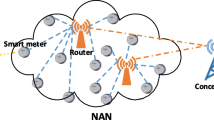Abstract
Nowadays, the power allocation and channel selection schemes are developed for smart meter (SM) systems using a variety of approaches. In this paper, we suggest a specific scenario for an SM configuration in the television white space system and show how to solve the optimization problem for transmission between SMs and the data concentrator unit (DCU), which collects data from several SMs. With this proposed scheme, SMs can have a transmission schedule and a channel selection mechanism to achieve optimal efficiency when using spectrum resources to transmit data to the DCU. The optimization goals of this study are achieving the maximum capacity or maximum channel efficiency and determining the maximum allowable power of the SMs used to satisfy the quality of service requirements without adversely affecting other wireless systems. In addition, we propose an optimization process with an interference analysis scheme by using the SEAMCAT tool and genetic algorithm for obtaining the best configuration of the SM system, considering the interference limitation for each SM in a specific configuration.







Similar content being viewed by others
References
IEEE standard for local and metropolitan area networks, part 15.4m: Low-rate wireless personal area networks (LR-WPANs), Standard IEEE, Dec 2013.
ECC report 185, complementary report to ECC report 159—Further definition of technical and operational requirements for the operation of white space devices in the band 470–790, Rep. ECC, Jan 2013.
ECC report 186, technical and operational requirements for the operation of white space devices under geo-location approach, Rep. ECC, 59 pp, Jan 2013.
Woyach, K., Grover, P., & Sahai, A. (2011). Near vs far field: Interference aggregation in TV whitespaces. IEEE GLOBECOM: Proceedings.
Goldberg, D. E., Korb B., & Deb, K. (1989). Messy genetic algorithms: Motivations, analysis, and first results. Complex system, 3(5), 493–530.
Gozupek D., & Alagoz, F. (2011). Genetic algorithm-based scheduling in cognitive radio networks under interference temperature constraints. International Journal of Communication Systems, 24(2), 239–257.
Coello, C. A. (2000). An updated survey of GA-based multiobjective optimization techniques, ACM Computing Surveys, 32(2), 109–143.
Srinivas, N., & Dev, K. (1994). Multiobjective optimization using nondominated sorting in genetic algorithms. Evolutionary computation, 2(3), 221–248.
Jensen, M. T. (2003). Reducing the run-time complexity of multi-objective EAs: The NSGA-II and other algorithms. IEEE Transactions on Evolutionary Computation, 7(5), 503–515.
Rahman, A. U., Qureshi, I. M., & Malik, A. N. (2012). Adaptive resource allocation in OFDM systems using GA and fuzzy rule base system. World Applied Sciences Journal, 18(6), 836–844.
Dionisio, R., Marques, P., Rodriguez, J. (2011). TV white spaces maps computation through interference analysis. Future network and mobile summit, IIMC.
Akl, R., Arepally, A. (2007). Dynamic channel assignment in IEEE 802.11 networks, PORTABLE07. IEEE International Conference.
Federal Communication Commission, FCC 10–174, 2010.
Derivation of a block edge mask for terminal stations in the 2.6 GHz frequency band, ECC report 131, 2009.
Spectrum engineering advantage Monte Carlo analysis tool (SEAMCAT) handbook, SEAMCAT handbook, 2010.
Cognitive radio system for efficient sharing of TV white spaces in European context (COGEU), D2.1: European TV white spaces analysis and COGEU use-cases, COGEU, 2010.
Recommendation ITU-R P.1546. Method for point-to-area predictions for terrestrial services in the frequency ranges 30 MHz to 3000 MHz, ITU, 2009.
CEPT Administrations. Monte-Carlo simulation methodology for the use in sharing and compatibility studies between different radio services of systems (ERC report 68), ERC within the CEPT, February 2000.
SEAMCAT Manual. SEAMCAT implementation of extended Hata and extended Hata-SRD models, www.seamcat.org.
Newman, T. R. (2007). Cognitive engine implementation for wireless multicarrier transceivers. Wireless Communications and Mobile Computing, 7(9), 1129–1142.
Mitola, J., & Maguire, G., Jr. (1999). Cognitive radio: Making software radios more personal. IEEE Personal Communications, 6(4), 13–18.
Shen, Z., Andrews, J. G., & Evans, B. L. (2003). Optimal power alloation in multiuser OFDM systems. In IEEE GLOBECOM '03 (Vol. 1, pp. 337–341).
Angelakis, V., Papadakis, S., Siris, V., & Traganitis, A. (2008). Adjacent channel interference in 802.11a: Modeling and testbed validation. In IEEE Radio and Wireless Symposium (Vol. 1, pp. 591–594).
Acknowledgments
This work was supported by the Power Generation and Electricity Delivery of the Korea Institute of Energy Technology Evaluation and Planning (KETEP) grant funded by the Korea government Ministry of Trade, Industry and Energy (No. 20131010501720). This research was also supported by the MSIP (Ministry of Science, ICT and Future Planning), Korea, under the C-ITRC (Convergence Information Technology Research Center) (IITP-2015-H8601-15-1001) supervised by the IITP (Institute for Information and Communications Technology Promotion).
Author information
Authors and Affiliations
Corresponding author
Rights and permissions
About this article
Cite this article
Huynh, C.K., Lee, W.C. Optimal Solution for Channel Selection and Power Allocation for TVWS-Based Smart Metering System. Wireless Pers Commun 85, 1653–1668 (2015). https://doi.org/10.1007/s11277-015-2860-x
Published:
Issue Date:
DOI: https://doi.org/10.1007/s11277-015-2860-x




